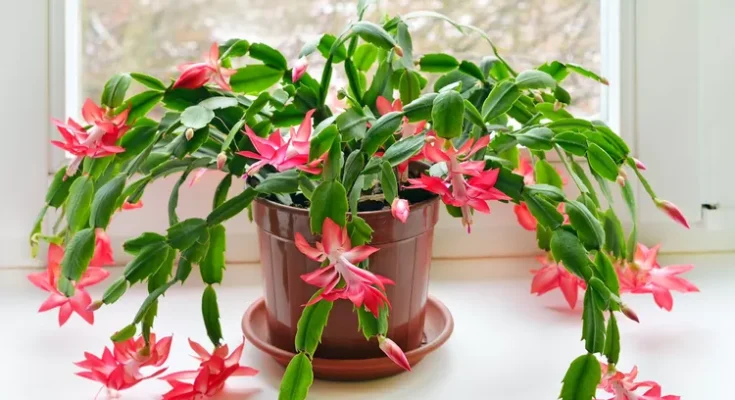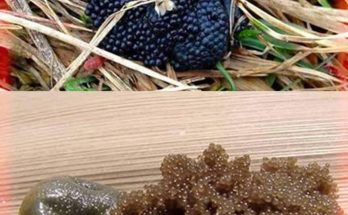With gorgeous blooms in festive hues, Christmas cactus makes a popular holiday gift. The exotic-looking flowers open just in time for the holidays and provide weeks of color. Christmas cacti are long-lived plants, blooming year after year in shades of red, purple, peach, and white. Learn how to care for a Christmas cactus so you can enjoy these holiday beauties for years to come.
Plant Attributes
| Common Name | Christmas cactus, holiday cactus |
| Botanical Name | Schlumbergera bridgesii |
| Family | Cactaceae |
| Plant Type | Succulent, cactus, perennial |
| Mature Size | 6-12 in. tall, 12-24 in. wide |
| Sun Exposure | Partial |
| Soil Type | Well-drained, loamy |
| Soil pH | Neutral, acidic |
| Bloom Time | Winter |
| Flower Color | Pink, purple, red, white, yellow, peach |
| Hardiness Zones | 10-12 (USDA) |
| Native Area | South America |
Christmas Cactus Care
Though they belong to the cactus family, Christmas cacti are native to rainforests, not deserts. In their native home in Brazil, Christmas cacti grow as epiphytes in the crooks of tree branches.1 For successful growth indoors, choose a well-draining potting soil containing perlite and a container with good drainage holes. Christmas cacti are sensitive to root rot. Avoid overwatering the plants, and do not let water sit in the saucer beneath containers. Water plants when the soil is dry to the touch. Plants can be allowed to dry out slightly during the spring and summer months but take care to maintain even soil moisture during flowering.
Light
Once the flowers fade, reduce watering until growth resumes in spring. While plants tolerate bright light during bloom, they perform better under partial shade conditions during the spring and summer months. Indoors, that might be a bright east- or north-facing window. Plants also perform well when brought outdoors for summer. Look for a location with filtered sunlight, such as under a tree (remember, they grow in rainforests). Too much light can cause plants to appear pale or yellow.
Soil
Plant a Christmas cactus in well-drained, lightweight soil. Three parts potting soil mixed with two parts perlite will provide good drainage. Or use a specially formulated cactus potting soil mix.
Water
Water the Christmas cactus only when it is dry to the touch, more during summer and less during winter as the temperature drops and buds are blooming. Use a well-draining pot to allow excess water to drain and to prevent the plant from becoming waterlogged. Do not let the plant sit in standing water. This can lead to root rot.
Temperature and Humidity
From April to September, keep the Christmas cactus at 70 to 80°F, as this is the time of peak growth for the plant. Once buds are set, the plant prefers lower nighttime temperatures at about 55 to 65°F. Keep the plant in a location free from drafts and sudden temperature changes. Provide humidity during dry winter months by misting the plant or placing the pot on a tray of pebbles filled with water.
Fertilizer
Fertilize plants when active growth resumes in spring, providing a balanced (such as 20-10-20) fertilizer at half strength. Continue monthly feedings through August. A fall feeding with a low nitrogen fertilizer (for example, 0-15-10) can boost flower bud formation. With proper care, a Christmas cactus can live for decades.
Types of Christmas Cactus
Christmas cactus (Schlumbergera bridgesii) belongs to a group of closely related plants that includes the Thanksgiving cactus (Schlumbergera truncata) and Easter cactus (Schlumbergera gaertneri), each named for the holiday during which they typically bloom. Collectively, they are referred to as holiday cacti.
- Thanksgiving cactus (Schlumbergera truncata): The species most commonly available in stores during the holiday season is actually Thanksgiving cacti, not Christmas cacti, because the bloom time corresponds to the holiday shopping season.
- Christmas cactus (Schlumbergera bridgesii): This species blooms from mid to late winter. The plant’s segments have more rounded edges.
- Easter cactus (Schlumbergera gaertneri): This plant buds in February with blooms from March through May. With rounded edges, Easter cacti sometimes have tiny hairs on their leaves.
Regardless of which species you may be growing, basic plant care remains the same.
Pinching and Pruning Your Christmas Cactus
A quick pruning in the summer months can encourage more flowers come winter. Pinch back stems in early June to promote branching, which in turn will result in more flowers at the shoot tips. Some growers also pinch plants back in September to create an even crown and remove immature stem segments. Immature stem segments (less than 1 cm) do not flower. Pinching back to a mature segment will encourage bud development.
Propagating a Christmas Cactus
Cuttings can be used to propagate new plants for family and friends. Taking cuttings from the plant will also help it to grow fuller. The best time to propagate is one to two months after blooming.
- Fill a 4- to 6-inch pot with potting soil, cactus soil mix, or a sand-peat mixture.
- Take cuttings of one to four segments and set them in a cool, dry place for several days until the cut end dries out. This prevents the end from rotting.
- Plant the cutting one inch deep into the soil. Water to keep moist.
- To create humidity, cover the plant with a plastic bag and secure it with a rubber band. Remove the bag when the roots have formed. Roots should form within two to three weeks.
- To root in water, place the cut ends into one to two inches of water and place them in indirect light. After several weeks, roots should form. When they are about two inches long, the cutting may be planted in soil.
How to Grow a Christmas Cactus From Seed
Harvest seeds from the plant’s pods, or fruit. If the pods are green, wait until they turn red, which is usually in the fall.
- Wash the pulp from the seeds, and plant them in moist cactus soil mix or a mixture of sphagnum peat moss and perlite. Press them lightly into the soil without covering them.
- Create humidity by covering the pot with plastic wrap or a plastic bag and placing it in indirect sunlight.
- Mist the soil’s surface daily, or water the plant from the bottom by placing the pot on a tray of water until the soil’s surface is moist.
- Remove the plastic covering after seedlings emerge, usually after a few weeks.
- Plant seedlings when they are about two to three inches tall.
Potting and Repotting
Christmas cacti don’t need to be repotted often, every three or four years, or when roots begin to grow from the pot’s drainage holes. They prefer to be rootbound. The best time to repot a Christmas cactus is in spring when blooming has ended and its flowers have wilted. Do not repot the plant while it is blooming.
- Transfer the plant to a pot that is the next size up. Place a couple of inches of fresh potting soil at the bottom of the pot. Gently loosen the roots and remove the old soil, then transfer the whole root ball to the pot.
- Place the plant in the new pot so the top of the root ball is about one inch below the surface. Pat down the soil around the plant.
- Provide moderate water and place in low light for a few days to give the plant time to adjust to the new pot.
Overwintering
As indoor plants, Christmas cacti bloom in the weeks around Christmas. As outdoor plants, they are cold-hardy in USDA zones 10-12. They can tolerate some cooler temperatures, as they need them to bloom, but they are tropical plants and cannot tolerate frost. Sudden temperature changes can cause the plants to lose their blooms. During summer, Christmas cacti can be placed outdoors with filtered sunlight and protection from wind.
Common Pests and Diseases
Overwatering can attract pests to your Christmas cactus. Common pests include mealybugs, spider mites, and aphids. These pests can cause wilting, yellowing, and stunted growth. To get rid of pests, use insecticidal soap and horticultural oil.
Fungal diseases can cause stem rot. Brown spots on stems at the soil line indicate fusarium, while phytophthora causes the stems near the soil line to appear wet. Apply a fungicide to treat the plant, though it may be hard to save.
How to Get a Christmas Cactus to Flower
Christmas cacti initiate flower bud formation in response to the shorter day lengths and cooler temperatures of autumn. The ideal conditions for flower bud formation include bright daylight followed by fourteen hours of continuous darkness in a cool environment with temperatures between 60 and 68°F. Plants may not bloom if temperatures remain too warm and/or plants do not receive the required amount of darkness. These can be challenging conditions to provide indoors where artificial heating and lights are normally used.
One option is to move plants into a seldom-used room, heated garage window, or other location where lighting can be controlled until flower buds develop. Once flower buds develop, plants can be moved back to their normal location for display, as day length does not affect flowering after the buds are set. For optimal bud development, provide dark night conditions for six weeks beginning in the middle of September. Maintain air temperatures between 60 and 68°F.
Christmas cacti are sensitive to being disturbed and may drop buds in response to sudden changes in temperature or humidity. Aim to provide similar conditions in the budding and display locations. Move plants as soon as buds appear to minimize bud drop. Continue to provide cool air temperatures. At 68ºF, flowering can last 7 to 8 weeks.
Another option is to place your Christmas cactus in a cool window and hope for the best. Cool temperatures can sometimes override day-length requirements. Plants grown with cooler night temperatures, between 50 and 59ºF, will often set flower buds regardless of day length. However, excessive cold can cause problems as well, with plants dropping flower buds when temperatures drop below 50ºF, so pay attention to nighttime lows.
Common Problems with Christmas Cacti
If your Christmas cactus has leaves that are turning red or pink, the plant may be getting too much sun or too little water. Move the plant out of direct light. If the soil is dry up to one-inch depth, it needs watering more often. Water the plant when the surface of the soil is dry.



